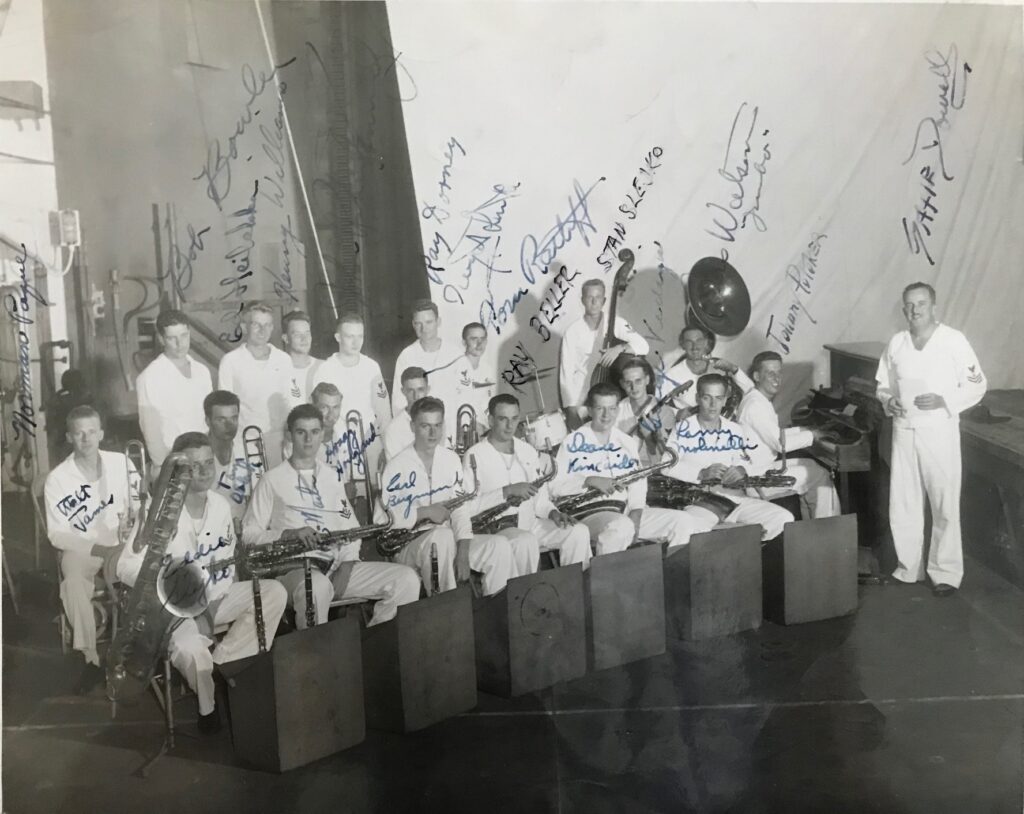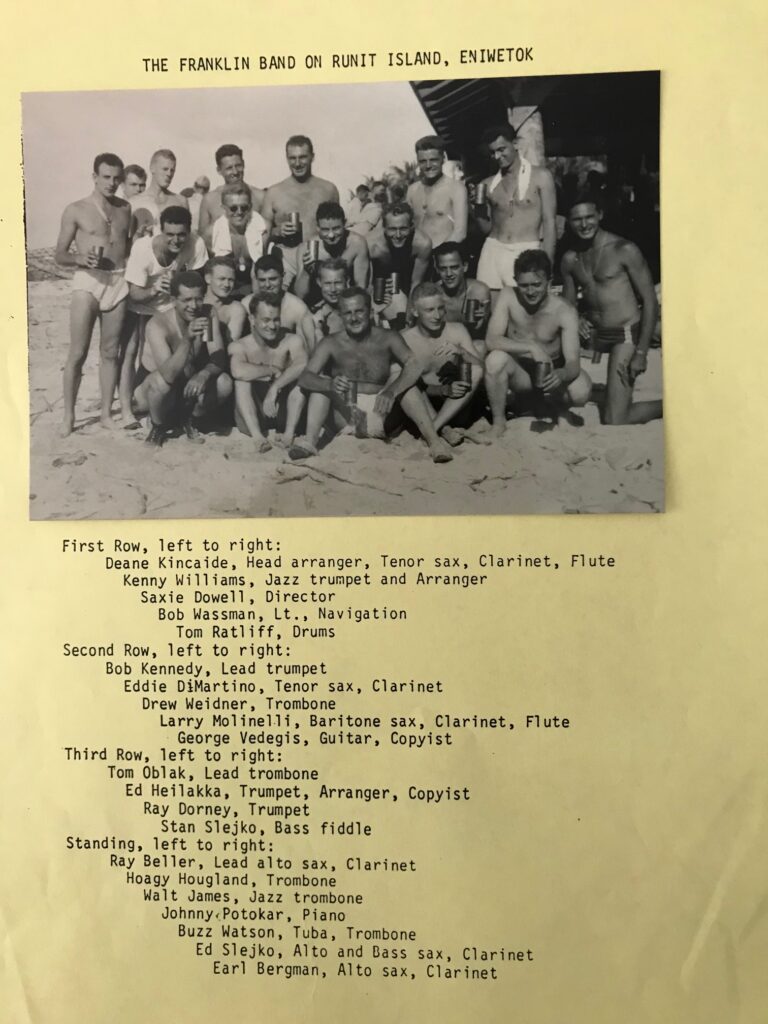Big Ben’s Big Band, The Franklin Flattoppers

I don’t know about you, but music played a significant role in my late teens and early twenties. For me, it was what is now known as Classic Rock.
The men who crewed USS Franklin were no different. The majority of the crew were also in their teens or twenties. For them, it was Swing, Jazz, Country, and more. Bing Crosby was popular with those who liked Crooners. Back home Frank Sinatra was adored by young women known as Bobby-soxers.1
During World War II, more than 6800 musicians served in the US Navy playing in around 285 bands.2 Many of the larger ships had bands and while most were composed of sailors that played for fun, Big Ben’s band was made up primarily of professional musicians. It was led by Musician 1st Class, Saxie Dowell. Dowell was somewhat famous in the 1930s and early ’40s for several arrangements, notably Three Little Fishes and Playmates.3 Franklin’s band, known as “The Flattoppers,” most likely played Swing, Jazz, and songs such as Anchors Aweigh and The Star-Spangled Banner.
The Flattoppers Come Aboard
Several versions are floating around about how the band came to be on Franklin, but one thing we know is that Saxie knew many musicians in many different bands. One version is that Captain Shoemaker, Franklin’s first commanding officer, knew Saxie and promised him a cushy life at Great Lakes Naval Training Station near Chicago. Until that is, Shoemaker was transferred to Naval Air Station Norfolk and then to USS Franklin. He took Saxie and the band with him.4 Another version is that, when Captain Shoemaker called Saxie to tell him that he, Shoemaker, was being given a ship, Saxie expressed an interest in going with him.5
Dowell also let his sense of humor come through in songs such as Knock, Knock, Who’s There? and Three Little Fishes. Additionally, he was known for songs such as I Was A Fool To Let You Go, The Air Raid Warden Song, Keeping out of Trouble, and Sweetheart Serenade.6
Bomb Day
The musicians were assigned to damage control for their battle stations. Some would serve near the sick bay; others at various stations around the ship. And several would lose their lives. Vergil “Drew” Widener, a Mus2/c, was one of the 56 killed during the kamikaze attack on 30 October 1944. He was a trombone player and vocalist.7
On 19 March 1945, when the Japanese bomber attacked, Saxie Dowell was eating breakfast in the crew’s messroom, telling others he was planning on opening a nightclub in Chicago after the war.8
Mus2/c Stanley Slejko, of Cleveland Ohio, had been recruited by Saxie to play in the band as had his brother Ed. Ed left the ship the week before the attack but Stan Slejko recalled:
“On the morning of March 19, 1945, I was at the damage control station at the officer’s mess quarters when we were dismissed to either eat or rest in our quarters. After seeing the long line waiting for chow on the hangar deck, I decided to go to my quarters to rest instead. My quarters were on the 4th deck below the servicemen’s mess hall forward of the ship. No sooner did I sack out when something rocked the ship, throwing me off my bunk. I immediately went to man my station but it was filled with dense smoke. I came back down to the servicemen’s mess quarters and proceeded aft of the ship. It was also filled with smoke and pushed me back so there was no place to go but to the forward end of the ship. Before I could get there, I heard many explosions rocking the ship like a toy. After the explosions subsided, I came out topside and manned water hoses. We were manning hoses all day and night to put out the fires.*

The band also suffered a casualty. Mus3/c William George Blanton was reported killed in action.9
Flattoppers Improvise
Except for one smoldering fire, by dusk efforts turned to clean up, salvage, and burial. For days afterward, as they managed to open flooded compartments, dozens of bodies were discovered and had to be buried at sea.10
Even though busy, the band found time to scrounge up some instruments. Most of them had been lost in the fire or explosions but they found several trumpets, a clarinet, and an ocarina. Someone contributed a penny whistle, Stan Slejko found a gallon jug to use instead of his bass, drums were made out of galley tubs and pie pans became cymbals.11
Saxie’s sense of humor emerged again as the ship pulled into Ulithi. The Flattoppers, with their makeshift instruments, were playing a parody of “The Old Gray Mare,” called “Old Big Ben, She Ain’t What She Used To Be!”
“Oh, the old Big Ben, she ain’t what she used to be,
Ain’t what she used to be, just a few days ago…
Bombs in the hangar deck…!”
The band repeated the performance when the ship arrived in Pearl Harbor days later.12 Stan Slejko left the ship at Pearl Harbor.13 Many other Flattoppers continued to their final destination at the Brooklyn Naval Yard.14
*My thanks to Dean Slejko, son of Flattopper Stan Slejko and nephew to Ed, who provided me with these pictures, his father’s unpublished biography, and much more information.
Footnotes
- 1940s in music. (2023, March 11). In Wikipedia. https://en.wikipedia.org/wiki/1940s_in_music
- Alex Albright website https://alexalbright.works/research/music/african-american-navy-bands-of-world-war-ii/Accessed 5 June 2023.
- Saxie Dowell. (2022, April 23). In Wikipedia. https://en.wikipedia.org/wiki/Saxie_Dowell
- Dean Slejko, The Artistic Life of Stan Slejko, v2.0(Unpublished biography 2023) 25, Joseph A. Springer, Inferno: The Epic Life and Death Struggle of The USS Franklin In World War II (Minneapolis: Zenith Press, 2011) 85-86
- Steve Jackson, Lucky Lady: the World War II heroics of the USS Santa Fe and Franklin (New York: Carroll and Graf, 2004) 111
- Slejko, 21
- Slejko, 29
- Lucky Lady, 372
- Slejko, 31
- J.Bryan, Aircraft Carrier (New York: Ballantine Books, 1982) 91
- John R. Satterfield, Saving Big Ben: the USS Franklin and Father Joseph T. O’Callahan (Annapolis: Naval Institute Press, 2011) 101-2; Slejko, 31-32
- A.A. Hoehling, The Franklin Comes Home (Annapolis: Naval Institute Press, 1997) 109
- Slejko, 30
- USS Franklin (CV-13) Original Documents 1943-1946 (Turner Publishing Co. 1994) 273-281